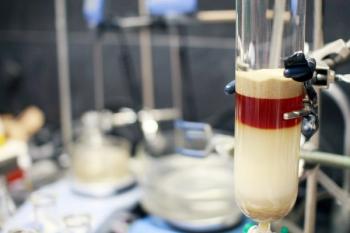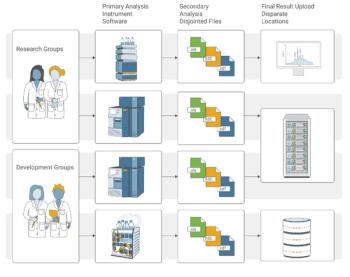
Tips & Tricks GPC/SEC Aqueous GPC/SEC for Water-Soluble Macromolecules
Water-soluble macromolecules require water as a mobile phase, and method development therefore seems to be straightforward. At second glance, however, aqueous gel permeation chromatography/size-exclusion chromatography (GPC/SEC) is complex and the choice of the stationary phase and pH are crucial. In addition, mobile phase additives are often required to allow for interaction-free separations.
Water-soluble macromolecules require water as a mobile phase, and method development therefore seems to be straightforward. At second glance, however, aqueous gel permeation chromatography/size-exclusion chromatography (GPC/SEC) is complex and the choice of the stationary phase and pH are crucial. In addition, mobile phase additives are often required to allow for interaction-free separations.
As water is an environmentally friendly and non-toxic solvent, aqueous gel permeation chromatography/size-exclusion chromatography (GPC/SEC) is preferred by many scientists. Polysaccharides, some synthetic polymers, proteins, and peptides are among the group of water-soluble macromolecules. Therefore, separation in an aqueous mobile phase is generally possible.
Stationary phases typically employed for water-based size separations exhibit a different surface chemistry compared to stationary phases used in organic solvents. For aqueous GPC/SEC the stationary phase surface has to be hydrophilic. Crossâlinked dextrans were among the first packings developed and are still applied today. Typical native silicas, although mechanically more robust and suitable for some applications, were found to be problematic for proteins as a result of strong ionic interactions with silanol groups (1). Therefore modified and functionalized silicas were developed for use in a variety of aqueous applications. Polymeric stationary phase materials based on methacrylate and acrylate (co)polymer networks with different functionalization are also very common (1). The advantages and disadvantages of silica- and polymerâbased materials have been discussed in a recent instalment of Tips & Tricks (2).
Typical pitfalls in aqueous GPC/SEC include algae growth, problems in sample preparation, and the increased risk of undesired interactions as a result of hydrophobic or hydrophilic parts and/or charged groups being present in the sample.
- The easiest problem to overcome is algae growth. As algae or bacterial growth may cause severe problems in aqueous GPC/SEC, additives, such as NaN3 or methanol, are added to suppress algae growth.
- Sample preparation is often an issue as inter- and intramolecular hydrogen bondings affect solubility. This might even result in insolubility in water for samples that, at first glance, appear to be water-soluble. Examples will be discussed in the sections below where the samples are grouped based on their chemistry.
- To avoid undesired interaction, it is important to select a stationary phase of suitable chemistry and to apply the most favourable mobile phase conditions by adjusting the pH value and the ionic strength. This reflects that GPC/SEC requires the polarity of sample, mobile phase, and stationary phase to be balanced.
The easiest and most practical approach to start stationary phase selection differentiates the types of waterâsoluble macromolecules based on their charged state. Neutral polymers can easily be analyzed on neutral stationary phases. The most difficult applications include polyampholytes and polymeric zwitterions where positive and negative charges are present simultaneously. In addition, proteins, where hydrophobic and hydrophilic patches might exist in the same molecule, present a challenge in aqueous GPC/SEC.
After selecting the appropriate stationary phase the mobile phase conditions need to be adjusted with respect to pH and ionic strength.
Typical Aqueous Applications
Polysaccharides: Polysaccharides are macromolecules made of monosaccharide units connected via glycosidic bonds. The composition and bonding sites of the different saccharide units determine the properties of the resulting macromolecule. Branching is very important in some polysaccharides.
Although water might appear to be a good solvent choice for all polysaccharides, this is not true. Some polysaccharides, for example, cellulose and starches, cannot be fully dissolved in water but require organic solvents and mobile phases such as dimethylacetamide (DMAc) or dimethyl sulfoxide (DMSO) (3). As a consequence these materials cannot be analyzed by aqueous GPC/SEC. Even if solubility in water can be achieved, sample preparation often requires specific protocols to be followed.
Easy-to-handle polysaccharides are samples without ionic groups, such as dextrans, pullulans, carrageenans, maltodextrins, or similar. These samples can be analyzed on neutral stationary phases, such as hydrophilic (meth)acrylic copolymer networks, and require mobile phases containing only minimal concentrations of electrolytes, such as NaCl or NaNO3.
If anionic groups, such as carboxylic groups, are present in the sample, neutral or negatively charged stationary phases are suitable. However, the mobile phase pH should be around 9. Under these conditions a reproducible charge state can be established. In addition, the mobile phase should provide sufficient ionic strength to shield electrostatic interaction. A good starting point is 0.07 M Na2HPO4. Examples are hyaluronic acid, pectin, or carboxymethyl cellulose.
Synthetic Polymers: There are some important water-soluble synthetic polymers, for example, polyethylene glycol (PEG), polyethylene oxide (PEO), poly(meth)acrylic acid (P[M]AA), polystyrene sulfonate, polyacrylamide, polyethylene imine (PEI), poly(DADMAC), and polyvinyl alcohol. These can be grouped according to their charge state.
PEG, although soluble in tetrahydrofuran (THF) up to a molar mass of approximately 50,000 Da, and polyethylene oxide (PEO) (a high molar mass analogue of PEG) are typically analyzed in water. As they are neutral molecules they can be analyzed on neutral stationary phases. Only minimal concentrations of electrolytes such as NaCl or NaNO3 are required. The same conditions apply for polyacrylamide and polyvinyl alcohol. In recent years polymerâbased columns with smaller particle sizes have been developed, yielding enhanced resolution of oligomers while still allowing for higher molar masses to be separated. Figure 1 shows an overlay of 12 different PEG molar mass standards. For the standard with the lowest molar mass a separation into single oligomers is achieved, for the second highest molar mass some oligomers can be identified.
Synthetic polyanions, such as poly(meth)acrylic acid polystyrene sulfonate, can also be analyzed on nearly neutral or negatively charged stationary phases, such as hydrophilic (meth)acrylic copolymer networks. Buffer solutions at weakly basic conditions with appropriate ionic strength should be applied. For example, 0.07 M Na2HPO4, which
provides a pH of approximately 9, is often suited. Care has to be taken if larger hydrophobic parts are present in the macromolecule. In those cases organic modifiers might be required to avoid hydrophobic interactions.
Polycations require a different approach. Examples of polycations are poly(DADMAC) or PEI. The amino groups in PEI are partially protonated in water, which results in positive charges. To achieve a fully charged state the pH needs to be <<7. In the fully charged state PEI can be analyzed in the same way as other polycations. These can be measured on positively charged surfaces, such as amino functionalized acrylate copolymer networks. In addition to acidic conditions, electrolytes are often added to increase the ionic strength and to shield electrostatic interaction (4). A good starting point for running polycations is 0.1 nNaCl with 0.1% trifluoro acetic acid.
Proteins and Peptides: For proteins and peptides two different applications are often asked for. Either the amount of aggregates in (otherwise monodisperse) proteins is measured or the molar mass distribution of proteins and peptide mixtures such as gelatine needs to be determined.
From a chromatographic point of view the challenge with running proteins and peptides is that they have a large number of functional or charged groups and are therefore prone to electrostatic interactions with silanol groups of silica-based packings. On the other hand proteins can have rather hydrophobic parts, resulting in hydrophobic interaction with the stationary phase. It is thus crucial to balance hydrophobicity and hydrophilicity by selecting an appropriate combination of mobile and stationary phase.
An advantage of proteins compared to water-soluble synthetic polymers or biomolecules is that proteins are usually small in size and the size distribution within a sample is relatively narrow, allowing analysts to fully benefit from the chromatographic potential of small particles. In addition, the narrow distribution allows columns with very flat calibration curves (high resolution in a narrow molar mass range) to be used. Therefore, silica-based GPC/SEC columns, which typically provide shallower calibration curves compared to polymerâbased materials, are a good choice for many protein applications.
An ideal GPC/SEC method for a protein would require using a mobile phase with pH matching the protein’s isoelectric point, pI. This is because under these conditions the net charge of the protein is zero. To avoid the cumbersome approach of adjusting the mobile phase pH for every single protein, a pH close to the protein’s pI is selected and monovalent salts, such as sodium chloride or potassium chloride, are added. The hydrophobicity of the protein determines the required ionic strength. In general, hydrophilic proteins should be run at high ionic strength while hydrophobic proteins and amino acids, such as alanine or substituted alanines, should be analyzed at low ionic strengths (5).
Conclusions
- Although method development for aqueous GPC/SEC seems straightforward, the choice of stationary phase and mobile phase additives requires knowledge of the sample chemistry.
- Sample solubility can limit the application of water-based GPC/SEC.
- For stationary phase selection samples should be grouped based on their charge state (neutral, anionic, cationic).
- Best results are obtained when the charges on the stationary phase and within the sample are comparable.
- Interactions need to be minimized by adjusting a proper pH and ionic strength.
References
- A.M. Striegel, J.J. Kirkland, W.W. Yau, and D.D. Bly, Modern Size-exclusion Liquid Chromatography, 2nd edition (John Wiley & Sons, Inc., New Jersey, USA, 2009).
- D. Held and K. Oleschko, The Column 16(1), 8–12 (2020).
- G. Reinhold, The Column 7(15), 13–17 (2011).
- W. Radke, The Column 14(6), 9–12 (2018).
- D. Held and T. Hofe, The Column 13(5), 18–23 (2017).
Daniela Held studied polymer chemistry in Mainz, Germany, and works in the PSS software and instrument department. She is also responsible for education and customer training.
Wolfgang Radke studied polymer chemistry in Mainz and Amherst, Massachusetts, USA, and is head of the PSS application development department. He is also responsible for instrument evaluation and for customized training.
Newsletter
Join the global community of analytical scientists who trust LCGC for insights on the latest techniques, trends, and expert solutions in chromatography.




